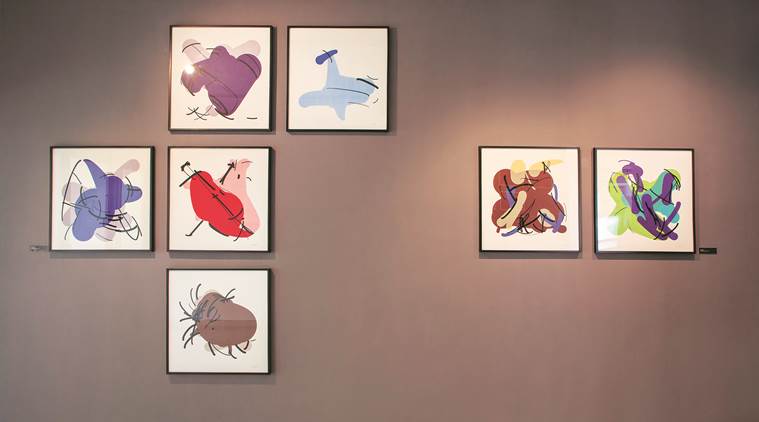Made by Machine
What happens when Artificial Intelligence gets creative? An exhibition explores an art form in its infancy

Works by Tom White
The gallery is decked with artwork of varied politics. On one wall are frames with colourful bubbles, blotches and squiggles that would look good in a schoolroom. On the opposite wall are gory images of plucked meat stuck to the bones. In one room, all by itself, a man’s face twists and eddies on loop in a giant video screen. What were the artists thinking? Except, that artists have not made these works, at least not entirely. “Gradient Descent” at Delhi’s Nature Morte, for the first time in India, features art created by artificial intelligence (AI).
The series of pictures of meat on bone is called The Anatomy Lessons of Dr Algorithm. The AI, trained by Harshit Agrawala — the only Indian artist in the group of seven and researcher of Human Computer Interaction — create art that is imagined human dissections. The machine’s gaze on the insides of human beings is disturbing and reminiscent of torsos in the aftermath of a bomb blast.
When Karthik Kalyanaraman, who has curated the show with his brother Raghava KK, was speaking to a curator friend in the US, her main question was, “What is the connection between AI and art?” “My whole point was, ‘Look at photography. That was considered purely technical in the beginning but, later, you developed it as an art form,” he says.
When computers get creative, it is because of an algorithm called Generative Adversarial Network (GAN), which is said to be the “coolest idea…in 20 years”. It was introduced in an academic paper by Ian Goodfellow of the University of Montreal in 2014 and made him one of the rockstars of AI research. “AI is a programme that learns to do something from examples and not rules. Imagine you are an art teacher and I am your student. You don’t teach me anything about composition, but show me a whole set of images. And you say, ‘This is good art and now you make something original after seeing all of this’. The human intervention is in curating or choosing that example for the AI,” says Kalyanaraman.
In the video work of a man’s distorted faces, titled 79530 Self-Portraits, the AI was fed massive amounts of portraits of the Old Masters. Ultimately, the machine began to interpret all images it saw as an Old Master portrait. When Mario Klingermann, a Munich-based artist in residence at Google Art and Culture, trained a webcam on his face and routed the images into the AI, the machine interpreted these — even when he was looking sideways or making weird faces — as front-facing Old Master portraits. The result is a range of distorted self-portraits. “Self-portraiture has been a huge genre in art and Mario questions what the self portrait is? Is it the machine which is producing the final images or is it the artist?” says Kalyanaraman.
Working with computers and algorithms, artists in the exhibition have trained the AIs on images from the Google Art Archive and self-created paintings, among others. “Training GAN is a delicate process. If you train them too quickly, or too slowly, they produce rubbish. Getting to the point where they are being creative is an art,” he adds.
Another video work, Deep Meditations by Memo Akten, who works with computation as a medium, shows a sandy beach changing into a star-filled sky and, in an instance, into a bird’s eye view of a mountain terrain. Accompanying these transforming images is a deep soundscape created by another AI algorithm that has been trained on religious chants, prayers and ritual music.
Does AI see differently from people? A New Zealand artist, who investigates machine perception, Tom White’s series, Perception Engines answers that. One work, of green curves and purple tubes, draws diverse interpretations from a group of viewers. One says the work depicts birds in flight, another says it is a weather chart and yet another calls it a plate of food. “Four different AIs interpreted this as porn. This image will be categorised as ‘imapproprita’ or ‘explicit content’ by online image analysis AIs,” says Kalyanaraman. Suddenly, you begin to see phallic symbols in the work and erotica in shapes and colours. AI just changed your perception.
At Nature Morte in Delhi till September 15






















 Anna Ridler’s Fall of the House of Usher
Anna Ridler’s Fall of the House of Usher Mario Klingemann’s 79530 Self-Portraits
Mario Klingemann’s 79530 Self-Portraits
No hay comentarios:
Publicar un comentario